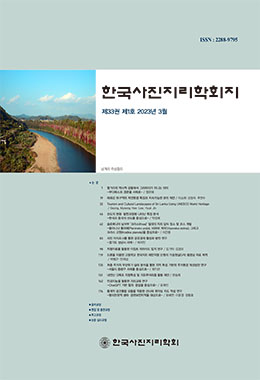본 연구는 중국과 우리나라 풍수서에 수록된 산도가 변화·발전하는 과정에 나타난 다양한 특징에 대해 살펴보는 것을 목적으로 한다. 중국 풍수서의 산도는 송대의 『옥수진경(玉髓眞經)』으로부터 비롯되었다. 이후 명대의 『인자수지(人子須知)』에서 꽃을 피우게 되는데, 우리나라 산도에 미친 영향이 가장 큰 풍수서이다. 우리나라 산도는 『결록(訣錄)』과 족보 그리고 왕실의 『선원보감(璿源寶鑑)』과 『능지(陵誌)』 등에서 활용되는데, 왕실의 산도와 민간의 산도는 활용 목적에 따라 작품의 유형도 다양하고 작품성도 큰 차이를 보인다. 또한 경제적인 이유와 기법의 차이 그리고 필사과정에서 변화와 왜곡이 이루어지는 다양한 모습을 연출한다. 결론적으로 다양한 의미와 형식 그리고 제작 배경을 가진 산도는 당시의 시대상을 이해하고 해석하는데 중요한 자료라 할 수 있다.
In this study, I intended to examine the various characteristics that appear in the process of change and development of fengshui mountain maps in Chinese and Korean fengshui books. Mountain maps in Chinese fengshui books originated from Yusuizhenjing(玉髓眞經) of the Song Dynasty. Afterward, it was most developed in Renzixuzhi(人子須知) of the Ming Dynasty, and i t had the most influence on Korea’s mountain maps. In Korea, we can see the mountain maps in Gyeollok(訣錄), genealogies, as well as in Seonwonbogam(璿源寶鑑) and Neungji(陵誌) of the royal family. Mountain maps of the royal family and those of the private sector have various types of works depending on the purpose of use and show a big difference in the quality of the work. In addition, economic circumstances, differences in techniques, and changes and distortions in the transcribing process produced diverse aspects. In conclusion, I confirm that mountain maps, which have various meanings, forms, and production backgrounds, would be significant material for understanding and interpreting the phases of the times.




